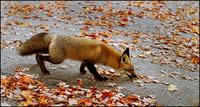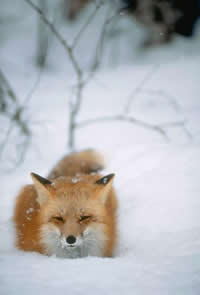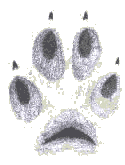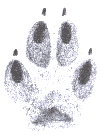Red Fox (Vulpes vulpes)
Ontario, Canada
Red foxes are known for their cleverness. Their scientific name
is "Vulpes Vulpes" which means "fox fox." This
beautiful and notoriously cunning fox is found throughout Ontario
and much of North America.
History
 Red
foxes probably were not found before colonial times. European settlers
released red foxes brought from Europe and other parts of northern
North America into the eastern United States. Red foxes were imported
primarily for the sport of hunting, an activity that had long been
a popular pastime in Europe. Since then, the red fox has been gradually
expanding it's range. Fox hunting is still a popular sport today.
Hounds are used to chase the fox while the hunters follow, usually
on horseback or sometimes on foot. The object of the hunt is often
just to chase the fox, many times the fox is not actually taken.
Besides being a game animal, red foxes are also considered fur bearers
and are taken during regulated trapping seasons. They are also raised
on game farms for their pelts. In years past, foxes, like many other
predators, were viewed as undesirable animals and bounties were
often paid to eliminate them. We now understand better the role
that foxes and other predators play in the ecology of our forests.
Red
foxes probably were not found before colonial times. European settlers
released red foxes brought from Europe and other parts of northern
North America into the eastern United States. Red foxes were imported
primarily for the sport of hunting, an activity that had long been
a popular pastime in Europe. Since then, the red fox has been gradually
expanding it's range. Fox hunting is still a popular sport today.
Hounds are used to chase the fox while the hunters follow, usually
on horseback or sometimes on foot. The object of the hunt is often
just to chase the fox, many times the fox is not actually taken.
Besides being a game animal, red foxes are also considered fur bearers
and are taken during regulated trapping seasons. They are also raised
on game farms for their pelts. In years past, foxes, like many other
predators, were viewed as undesirable animals and bounties were
often paid to eliminate them. We now understand better the role
that foxes and other predators play in the ecology of our forests.
Appearance
 The
ears are prominent and the tail is long and bushy with a white tip.
The
ears are prominent and the tail is long and bushy with a white tip.
Coloration of red foxes can ranges from pale yellowish red to deep reddish brown on the upper parts and white, ashy or slaty on the underside. The usual coloration is a bright rusty-red with black feet, legs and backs of the ears, a whitish belly and the tail usually has a white or black tip.
The fox goes through colour phases of black, silver, and a cross phase in which a dark area crosses over the shoulders and down the middle of the back. Two color variants commonly occur. The cross fox has reddish brown fur and has a black stripe down its back and another across its shoulders. The silver fox ranges from strong silver to nearly black and is the most prized by furriers. These variants are about 25% and 10% of the species, respectively.
Red foxes, like many other canids, have tail glands. In Vulpes vulpes this gland is located 75 mm above the root of the tail on its upper surface and lies within the dermis and subcutaneous tissue.
The eyes of mature animals are yellow.
The nose is dark brown or black.
The dental formula is 3/3 1/1 4/4 2/3. The tooth row is more than
half the length of the skull. The premolars are simple and pointed,
with the exception of the carnasiallized upper fourth premolar.
The molar structure emphasizes crushing.
The manus has 5 claws and the pes 4 claws. The first digit, or dew
claw, is rudimentary but clawed and does not contact the ground.
Red foxes measure in total length from about 39 to 41 inches and
weigh between 10 and 15 pounds.
Red foxes grow an extra-large fur coat during the winter to keep them warm.
Habitat
Red foxes seem to prefer meadows, stream banks and other open areas, but also inhabits woodlands and are not creatures of dense forests. They are found mostly in areas with interspersed croplands, old fields, and woodlots, especially along the edges formed by these habitats.
It is secretive and largely nocturnal.
Food
 Because
of its well-developed sense of hearing, sight, and smell the red
fox is an efficient and lethal predator; essentially an omnivore
it eats whatever is available.
Because
of its well-developed sense of hearing, sight, and smell the red
fox is an efficient and lethal predator; essentially an omnivore
it eats whatever is available.
Most of their hunting is done at night, and they can travel over five miles in one night just hunting. Red foxes hunt by themselves, and live usually around the edge of forests.
Their winter diet consists mainly of small mammals such as mice, squirrels, and rabbits. In the summer months, insects, crayfish, earthworms, beetles, fruit including corn, berries (particularly blackberries) , apples, grasses, and vegetable matter play a more important part in their feeding habits. They will also eat carrion.
They're good at catching mice, very good, because they can hear one squeal almost 150 yards away. Red foxes have a characteristic manner of hunting mice. The fox stands motionless, listening and watching intently for a mouse it has detected. It then leaps high and brings the forelimbs straight down forcibly to pin the mouse to the ground.
Daily food consumption is between 0.5 and 1 kg a day.
Range
Found throughout Ontario and much of North America
The red fox is found throughout Canada, Alaska, almost all of the contiguous US, all of Europe and Britain and almost all of Asia including Japan. There are also several populations in North Africa. Red foxes were introduced into Australia in the nineteenth century.
Foxes at least partly territories, individual adults have home ranges that vary in size depending on the quality of the habitat. In good areas ranges may be between 5 and 12 square kilometers; small as 0.2 square kilometers in urban areas; in poorer habitats ranges are larger, between 20 and 50 square kilometers in hill country. During some parts of the year adjacent ranges may overlap somewhat, but parts may be regularly defended.
Each territory is occupied by a fox family group. These often consist of a pair - dog fox and one or two vixen - and their associated cubs. However, in areas where foxes are not persecuted and where there is a plentiful supply of food, a family group may contain several adults.
Behavior
 They
remain active throughout the year but are primarily nocturnal, only
occasionally coming out during the daylight hours. Red foxes have
the reputation of being cunning, but shy. Like most other members
of the wild dog family, they seem to be quite intelligent and are
very adaptable, often learning to live quite close to humans.
They
remain active throughout the year but are primarily nocturnal, only
occasionally coming out during the daylight hours. Red foxes have
the reputation of being cunning, but shy. Like most other members
of the wild dog family, they seem to be quite intelligent and are
very adaptable, often learning to live quite close to humans.
Red foxes are solitary animals and do not form packs like wolves. Individuals and family groups have main earthen dens and often other emergency burrows in the home range. Dens of other animals, such as rabbits or marmots, are often taken over by foxes. Larger dens may be dug and used during the winter and during birth and rearing of the young. The same den is often used over a number of generations. Pathways throughout the home range connect the main den with other resting sites, favored hunting grounds and food storage areas. Red foxes are terrestrial and either nocturnal or crepuscular.
In the autumn following birth, the pups of the litter will disperse to their own territories. Dispersal can be to areas as nearby as 10 km and as far away as almost 400 km. Animals remain in the same home range for life.
Breeding Biology
The males and females pair for life, usually breeding in late winter. Red foxes dig a den or often utilize an abandoned groundhog burrow or other similar location to raise their young.
The annual estrous period of female red
foxes last from 1 to 6 days. Ovulation is spontaneous and does not
require copulation to occur. The exact time of estrous and breeding
varies across the broad geographic range of the species: December-January
in the south, January-February in the central regions, and February-April
in the north. Males will fight during the breeding season. Males
have a cycle of fecundity, with full spermatogenesis only occurring
from November to March. Females may mate with a number of males
but will establish a partnership with only one male. Copulation
usually lasts 15 or 20 minutes and is often accompanied by a vocal
clamor. Implantation of the fertilized egg occurs between 10 and
14 days after a successful mating. Just before and for a time after
giving birth the female remains in or around the den. The male partner
will provision his mate with food but does not go into the maternity
den. Both of the parents help to care for the pups, although the
male provides most of the food for both the pups and the female
until the pups are old enough to stay alone for short periods of
time.
Gestation is typically between 51 and 53 days but can be as short
as 49 days or as long as 56 days.
Litters vary in size from 1 to 13 pups with an average of 5.
Birth weight is between 50 and 150 g.
The pups are born blind and deaf in a den (called an earth) but
open their eyes 9 to 14 days after birth. A vixen stays in the earth
with her cubs for the first two weeks of their lives. Pups leave
the den 4 or 6 weeks after birth and are fully weaned by 8 to 10
weeks. Mother and pups remain together until the autumn after the
birth. Sexual maturity is reached by 10 months.
Predators/Threats
The fox has many enemies including
coyote, lynx, bobcats,Golden eagles as they may snatch away one
or more of the newborn pups and humans. It is also susceptible to
rabies.
Red foxes are often hunted for their fur. But it seems that all
that does is teach them more tricks to get away.
Lifespan
Foxes generally do not live very long; although they have been recorded up to nine years old in the wild, most survive only one or two years.
Track
This fox has very hairy feet making finer details obscure, therefore only parts of the toes and heel pads show.
The trail of the red fox generally follows fence lines and the edges of forests and fields in a straight line of alternating prints, with hind print direct registering on the wider fore print, but this line may vary depending on the animals speed and gait. When a fox trots, the hind print fall to one side of the fore print. The print is usually smaller, longer and narrower than that of a dogs. The front print is wider and larger than the pointed hind print. The heel pad is an inverted V-shape with a unique calloused ridge across the center of the pad.
Top speed is about 48 km/h and obstacles as high as 2 m can be leapt.
Prints:
|
Fore and Hind Prints
Length: 2.1 - 3.0 in (5.3 - 7.6 cm)
Width: 1.6 - 2.3 in (4.1 -5.8 cm)
Straddle
2.0 - 3.5 in (5.1 - 8.9 cm)
Stride
Walking: 12 - 18 in (31 - 46 cm)
Trotting: 14 - 21 in (36 - 53 cm)
Size (vixen slightly smaller)
Height: 14 in (36 cm)
Length: 22 - 25 in (56 - 64 cm)
Weight
Males: 3.2 -7kg
Females: 3.2 - 6kg
Similar Species:
Small Coyote - smaller print wider straddle,
domestic dog - lack bar on heel pad, erratic trail, shorter stride
gray fox - shorter stride and wider straddle




